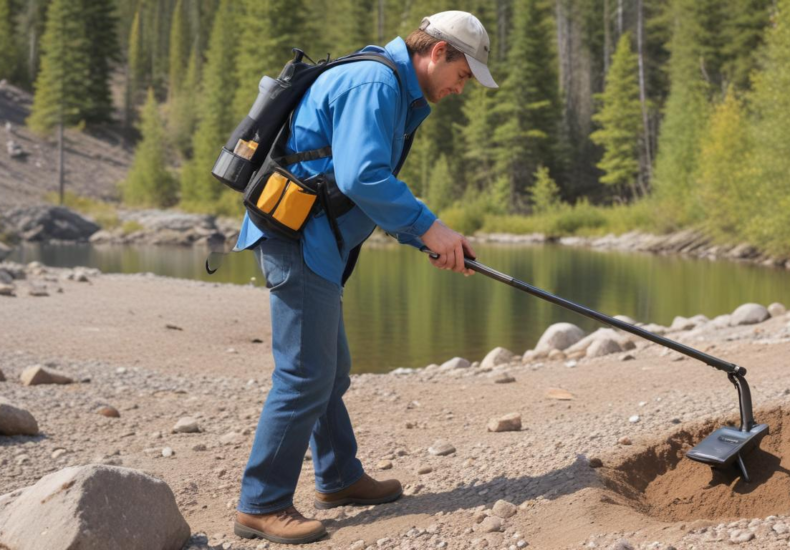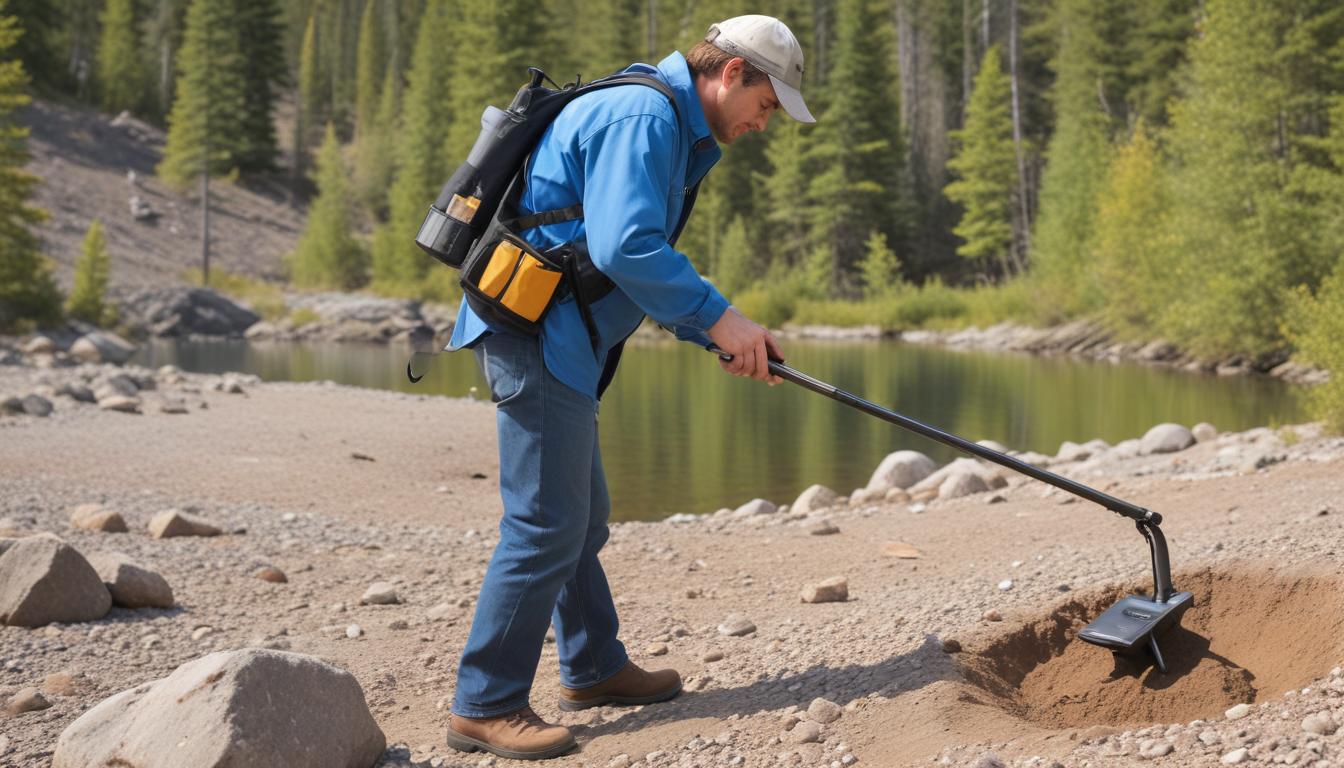
Best metal detectors for gold prospecting
Gold prospecting with a metal detector can be an exciting and potentially rewarding hobby. To get started, it’s essential to understand the different types of metal detectors available for gold detection, as each is suited to varying environments and types of gold deposits. The most common metal detectors used in gold prospecting include Very Low Frequency (VLF), Pulse Induction (PI), and Multi-Frequency (MF) detectors.
VLF detectors are popular among gold prospectors because they are highly sensitive to small gold nuggets and can discriminate against various types of metals. This means they can distinguish gold from iron and other common minerals. These detectors operate at frequencies ranging from 3 kHz to 70 kHz, with higher frequencies typically being more sensitive to smaller gold pieces. However, their effectiveness can decrease in highly mineralized soils, where ground mineralization can cause false signals.
Pulse Induction detectors, on the other hand, are specifically designed to excel in areas with heavy mineralization, where VLF detectors might struggle. Although PI detectors are generally less sensitive to small nuggets compared to VLF detectors, they provide superior depth and are better suited for searching in saltwater and heavily mineralized ground. Their technology allows them to ignore ground minerals and focus on the targets, making them ideal for gold prospecting in challenging terrains.
Finally, Multi-Frequency detectors are versatile metal detectors that use more than one frequency at a time. This makes them adaptable to a variety of soil conditions and capable of locating both large and small gold nuggets. They combine the benefits of VLF and PI technology, offering good sensitivity and depth, with the added ability to handle different terrains and mineral levels.
Each type of detector has its strengths and limitations, so the choice of a metal detector for gold prospecting should be based on the specific conditions of the areas you plan to explore, as well as the size of gold you are targeting. Whether it’s the versatile VLF, the powerful PI, or the adaptable MF, the right metal detector can significantly enhance your gold detecting efforts.
Features to consider when choosing a gold metal detector
Choosing the right metal detector for gold prospecting requires careful consideration of several features to ensure you are equipped with the best tool for your specific needs. Different detectors offer a variety of features, but some of the most critical to assess include sensitivity and depth, discrimination capabilities, ground balance control, and additional functionalities like GPS and automation settings.
Sensitivity and depth are particularly crucial when selecting a gold metal detector. The sensitivity measures how small of a gold nugget the detector can sense. This feature is vital for gold prospecting, where even tiny specks can be valuable. Depth capability, on the other hand, determines how deep into the ground the metal detector can effectively detect metal objects. Metal detectors with greater depth capabilities increase your chances of finding gold nuggets buried deep in the ground.
Discrimination is another key feature to look for. This function allows the metal detector to differentiate between various types of metals and ignore unwanted items. For gold prospectors, having strong discrimination capabilities can mean the difference between striking gold and excavating trash, saving precious time and effort during searches.
Ground balance control is essential when prospecting in different types of soil, especially in highly mineralized ground. This feature allows the metal detector to adjust to the soil’s mineral content, reducing false signals and improving the machine’s overall performance in difficult conditions. Some advanced metal detectors offer automatic ground balance, which adjusts on-the-fly, while others require manual adjustment, giving users full control over the calibration.
Additional features such as GPS and automation settings can also enhance the gold prospecting experience. GPS features help prospectors mark and navigate back to successful or interesting spots. Automation settings, which might include preset modes for different environments, can simplify the use of the metal detector, making it easy for both beginners and seasoned prospectors to achieve optimal results with minimal manual adjustments.
When evaluating these features, consider how they fit with the specific environments you plan to explore in your gold prospecting endeavors. The right combination of sensitivity, depth, discrimination, ground balance, and additional functionalities can greatly influence the effectiveness and enjoyment of your gold-detecting activities.
Top-rated metal detectors for gold
When it comes to selecting the top-rated metal detectors for gold, several models stand out due to their advanced technology, user reviews, and expert recommendations. Among the most acclaimed metal detectors specifically tailored for gold detecting, the Garrett AT Gold, Fisher Gold Bug Pro, and Minelab GPZ 7000 are frequently mentioned as the best choices for serious gold prospectors.
The Garrett AT Gold is particularly favored for its all-terrain versatility and its high frequency of 18 kHz, which provides excellent sensitivity to small gold nuggets. Its waterproof design allows it to be used in shallow water, making it a great option for prospecting in streams and rivers. An integrated manual ground balance adjusts the metal detector to the mineralized soil conditions, enhancing its performance in hard-to-navigate areas filled with natural gold hotspots.
Another standout model, the Fisher Gold Bug Pro, offers a highly effective combination of sensitivity and depth, featuring a frequency optimized for gold prospecting at 19 kHz. This metal detector is renowned for its ability to find the tiniest gold flakes and nuggets, thanks to its VLF technology. Its user-friendly interface and real-time ground balancing provide immediate feedback and ensure that the detector is always set optimally for the conditions at hand, making it an excellent tool for beginners and pros alike.
For those who are in need of extreme depth and sensitivity, the Minelab GPZ 7000 is the top-tier option. Utilizing zero voltage transmission (ZVT) technology, this metal detector can reach deeper into the ground than most other detectors and is highly sensitive to both large and small gold deposits. Although it comes with a higher price tag, its capabilities justify the investment for serious prospectors who are targeting gold in highly mineralized and challenging environments.
Each of these metal detectors has been proven to perform exceptionally well in the realm of gold prospecting. Prospective buyers should weigh their specific needs, such as the type of terrain they will explore and the typical size of the gold nuggets in their target areas, to select the most suitable metal detector. With one of these top-rated models, enthusiasts can substantially enhance their prospecting outcomes and enjoy the thrilling experience of discovering natural treasures.
Tips for successful gold prospecting with a metal detector

Successful gold prospecting with a metal detector requires more than just having top-notch equipment; it demands technique, patience, and a bit of luck. Here are several tips to help you enhance your gold detecting efforts and increase your chances of finding those elusive gold nuggets.
Firstly, it’s crucial to thoroughly understand your metal detector’s capabilities and settings. Take the time to practice with your detector in various environments before venturing out on serious expeditions. Knowing how to quickly adjust its ground balance, sensitivity, and discrimination settings can make a significant difference, especially when you are in challenging terrains.
Research is your golden ticket in gold prospecting. Investing time in studying historical gold finds in your area can guide you to more prospective spots. Old maps and miner’s records can direct you to abandoned mines or old rivers and streams where gold was once found. Additionally, local prospecting clubs can be invaluable sources of advice and may even grant you access to private lands where you can prospect.
When you hit the field, start by targeting areas around old mining operations—these are often hotspots for gold. Riverbeds, streams, and old wash-up areas can also be lucrative places to search. Gold tends to settle in crevices and depressions in the land, so these should be your primary areas of focus with your metal detector.
Patience and persistence are essential in gold prospecting. You may need to sweep an area multiple times to detect gold that might have been missed initially. Moreover, varying your approach angle can sometimes reveal hidden nuggets, as modern detectors can detect gold more efficiently depending on the angle at which the search coil approaches the target.
Lastly, ensure you are prospecting legally. Always check local laws regarding metal detecting and prospecting, particularly those pertaining to national parks, state lands, and private property. Securing the necessary permissions can prevent legal troubles and respect landowner rights, making your gold prospecting adventure enjoyable and stress-free.
By applying these tips, you can make the most of your metal detector and potentially increase your gold haul. Every outing can teach you new techniques and ways to fine-tune your searching skills, gradually building your proficiency in the exciting world of gold prospecting.
Maintenance and care for your gold metal detector
Proper maintenance and care of your gold metal detector are essential to ensure its longevity and optimal performance, particularly if you frequently indulge in gold prospecting. Whether you’re traversing rugged terrains in search of gold or navigating through muddy waters, your metal detector is exposed to various environmental elements that can affect its functionality.
The first step in maintaining your metal detector is regular cleaning. After each use, wipe down the detector’s body, control box, and search coil with a soft cloth to remove dirt, mud, or any moisture. Be sure to pay special attention to the control box, as it is the heart of your metal detector. Although many detectors are designed to be weather-resistant, they are not necessarily waterproof, especially the control panel. Avoid using harsh chemicals or abrasive materials for cleaning, as these can damage the device’s components.
The search coil, in particular, is prone to scratches and nicks, which can affect its sensitivity over time. A coil cover does not only protect the coil from abrasive damage but also minimizes wear and tear. It’s a worthy investment if your gold detecting involves rough conditions. Additionally, make sure the coil is always securely attached to the shaft; a loose coil can lead to false signals.
Battery care is another crucial aspect. Always remove the batteries when the metal detector is not in use for extended periods. This prevents potential leakage and corrosion that could damage the battery compartment and the internal circuitry of the metal detector. For rechargeable models, follow the manufacturer’s instructions regarding charging practices to maximize battery life and performance.
Storage conditions also play a significant role in the care of your metal detector. Store your metal detector in a cool, dry place away from direct sunlight and extreme temperatures. If possible, hang it or place it in a padded case to prevent any undue stress on the device. Avoid storing your metal detector with the search coil compressed or bent, as this can warp the coil over time.
Lastly, it’s beneficial to periodically check all the connectors and cables for any signs of wear or loose connections. Tighten any loose parts and replace worn-out cables to prevent malfunctions during your gold prospecting excursions. Regular firmware updates, if available for your model, can also help in keeping the detector’s technology up to date.
By adhering to these maintenance and care guidelines, you can significantly extend the life and enhance the functionality of your gold metal detector, ensuring that it remains a reliable companion in your gold prospecting adventures.
You may also like
Archives
Calendar
| M | T | W | T | F | S | S |
|---|---|---|---|---|---|---|
| 1 | 2 | |||||
| 3 | 4 | 5 | 6 | 7 | 8 | 9 |
| 10 | 11 | 12 | 13 | 14 | 15 | 16 |
| 17 | 18 | 19 | 20 | 21 | 22 | 23 |
| 24 | 25 | 26 | 27 | 28 | 29 | 30 |
Leave a Reply